The Characteristics and Evolution of Structural and Functional Connectivity in a Large Catchment (Poyang Lake) during the Past 30 Years
Abstract
1. Introduction
2. Materials and Methods
2.1. Study Area
2.2. Methodology
2.2.1. Structural Connectivity Index
2.2.2. Functional Connectivity Index (IC)
2.3. Data Collection and Processing
3. Results
3.1. River System Accuracy and Spatial Pattern Evolution
3.2. Characteristics of Structural River Connectivity
3.2.1. Quantity and Morphometric Characteristics
3.2.2. Structural Characteristics of Connectivity
3.3. Characteristics of Functional River Connectivity
3.3.1. Spatiotemporal Changes in the IC Index
3.3.2. Relationships between Connectivity, Land Use, Runoff, and Sediment
4. Discussion
5. Conclusions
Author Contributions
Funding
Conflicts of Interest
References
- Li, Y.; Li, J.; Li, Z.; Liu, X.; Tian, Y.; Li, A. Issues and challenges for the study of the interconnected river system network. Resour. Sci. 2011, 33, 386–391. (In Chinese) [Google Scholar]
- Li, P.; Xu, G.; Lu, K.; Zhang, X.; Shi, P.; Bai, L.; Ren, Z.; Pang, G.; Xiao, L.; Gao, H.; et al. Runoff change and sediment source during rainstorms in an ecologically constructed watershed on the Loess Plateau, China. Sci. Total Environ. 2019, 664, 968–974. [Google Scholar] [CrossRef] [PubMed]
- Pino, J.; Marull, J. Ecological networks: Are they enough for connectivity conservation? A case study in the Barcelona Metropolitan Region (NE Spain). Land Use Policy 2012, 29, 684–690. [Google Scholar] [CrossRef]
- Pringle, C. What Is Hydrologic Connectivity and Why Is It Ecologically Important? Hydrol. Process. 2003, 17, 2685–2689. [Google Scholar] [CrossRef]
- Wainwright, J.; Turnbull, L.; Ibrahim, T.G.; Lexartza-Artza, I.; Thornton, S.F.; Brazier, R.E. Linking environmental régimes, space and time: Interpretations of structural and functional connectivity. Geomorphology 2011, 126, 387–404. [Google Scholar] [CrossRef]
- Heckmann, T.; Cavalli, M.; Cerdan, O.; Foerster, S.; Javaux, M.; Lode, E.; Smetanová, A.; Vericat, D.; Brardinoni, F. Indices of sediment connectivity: Opportunities, challenges and limitations. Earth-Sci. Rev. 2018, 187, 77–108. [Google Scholar] [CrossRef]
- Najafi, S.; Dragovich, D.; Heckmann, T.; Sadeghi, S.H. Sediment connectivity concepts and approaches. Catena 2021, 196, 104880. [Google Scholar] [CrossRef]
- Zhang, Y.; Huang, C.; Zhang, W.; Chen, J.; Wang, L. The concept, approach, and future research of hydrological connectivity and its assessment at multiscales. Environ. Sci. Pollut. R. 2021, 28, 52724–52743. [Google Scholar] [CrossRef]
- Wohl, E.; Brierley, G.; Cadol, D.; Coulthard, T.J.; Covino, T.; Fryirs, K.A.; Grant, G.; Hilton, R.G.; Lane, S.N.; Magilligan, F.J.; et al. Connectivity as an emergent property of geomorphic systems. Earth Surf. Proc. Landf. 2019, 44, 4–26. [Google Scholar] [CrossRef]
- Ali, G.A.; Roy, A.G. Shopping for hydrologically representative connectivity metrics in a humid temperate forested catchment. Water Resour. Res. 2010, 46, 65–74. [Google Scholar] [CrossRef]
- Lane, S.N.; Brookes, C.J.; Kirkby, M.J.; Holden, J. A network-index-based version of TOPMODEL for use with high-resolution digital topographic data. Hydrol. Process. 2004, 18, 157–171. [Google Scholar] [CrossRef]
- Ludwig, J.A.; Eager, R.W.; Bastin, G.N.; Chewings, V.H.; Liedloff, C. A leakiness index for assessing landscape function using remote sensing. Landsc. Ecol. 2002, 17, 157–171. [Google Scholar] [CrossRef]
- Borselli, L.; Cassi, P.; Torri, D. Prolegomena to sediment and flow connectivity in the landscape: A GIS and field numerical assessment. Catena 2008, 75, 268–277. [Google Scholar] [CrossRef]
- Nicoll, T.; Brierley, G. Within-catchment variability in landscape connectivity measures in the Garang Catchment, upper Yellow River. Geomorphology 2017, 277, 197–209. [Google Scholar] [CrossRef]
- Persichillo, M.G.; Bordoni, M.; Cavalli, M.; Crema, S.; Meisina, C. The role of human activities on sediment connectivity of shallow landslides. Catena 2018, 160, 261–274. [Google Scholar] [CrossRef]
- Arabkhedri, M.; Heidary, K.; Parsamehr, M.R. Relationship of sediment yield to connectivity index in small watersheds with similar erosion potentials. J. Soil Sediment 2021, 21, 2699–2708. [Google Scholar] [CrossRef]
- Liu, W.; Shi, C.; Ma, Y.; Li, H.; Ma, X. Land use and land cover change-induced changes of sediment connectivity and their effects on sediment yield in a catchment on the Loess Plateau in China. Catena 2021, 207, 105688. [Google Scholar] [CrossRef]
- Shao, X.; Fang, Y.; Cui, B. A model to evaluate spatiotemporal variations of hydrological connectivity on a basin-scale complex river network with intensive human activity. Sci. Total Environ. 2020, 723, 138051. [Google Scholar] [CrossRef]
- Zhang, X.; Li, F.; Zhao, Y. Impact of changes in river network structure on hydrological connectivity of watersheds. Ecol. Indic. 2023, 146, 109848. [Google Scholar]
- Deng, X.; Xu, Y.; Han, L.; Yang, M.; Yang, L.; Song, S.; Li, G.; Wang, Y. Spatial–temporal evolution of the distribution pattern of river systems in the plain river network region of the Taihu Basin, China. Quatern. Int. 2016, 392, 178–186. [Google Scholar] [CrossRef]
- Hu, Q.; Feng, S.; Guo, H.; Chen, G.; Jiang, T. Interactions of the Yangtze River flow and hydrologic processes of the Poyang Lake, China. J. Hydrol. 2007, 347, 90–100. [Google Scholar] [CrossRef]
- Duan, W.; He, B.; Nover, D.; Yang, G.; Chen, W.; Meng, H.; Zou, S.; Liu, C. Water quality assessment and pollution source identification of the eastern Poyang Lake Basin using multivariate statistical methods. Sustainability 2016, 8, 133. [Google Scholar] [CrossRef]
- Chen, M.; Xu, X. Lake Poyang ecosystem services changes in the last 30 years. J. Lake Sci. 2021, 33, 309–318. (In Chinese) [Google Scholar]
- Li, X.; Zhang, Q.; Xu, C.-Y.; Ye, X. The changing patterns of floods in Poyang Lake, China: Characteristics and explanations. Nat. Hazards 2015, 76, 651–666. [Google Scholar] [CrossRef]
- Read, E.K.; Patil, V.P.; Oliver, S.K.; Hetherington, A.L.; Brentrup, J.A.; Zwart, J.A.; Winters, K.M.; Corman, J.R.; Nodine, E.R.; Woolway, R.I.; et al. The importance of lake-specific characteristics for water quality across the continental United States. Ecol. Appl. 2015, 25, 943–955. [Google Scholar] [CrossRef] [PubMed]
- Xia, Y.; Fang, C.; Lin, H.; Li, H.; Wu, B. Spatiotemporal evolution of wetland eco-hydrological connectivity in the Poyang Lake area based on long time-series remote sensing images. Remote Sens. 2021, 13, 4812. [Google Scholar] [CrossRef]
- Li, Y.; Zhang, Q.; Liu, X.; Tan, Z.; Yao, J. New Insights on the surface hydrological connectivity of water depth thresholds in a flood-pulse-influenced floodplain system (Poyang Lake, China). Stoch. Environ. Res. Risk A 2021, 35, 861–879. [Google Scholar] [CrossRef]
- Liu, Z.; Lu, J.; Huang, J.; Chen, X.; Zhang, L. Projection of reference crop evapotranspiration under future climate change in Poyang Lake watershed, China. J. Hydrol. Eng. 2021, 26, 05020042. [Google Scholar] [CrossRef]
- Wu, G.; Liu, Y.; Zhao, X.; Ye, T. Spatio-temporal variations of evapotranspiration in Poyang Lake Basin using MOD16 products. Geogr. Res. 2013, 32, 617–627. (In Chinese) [Google Scholar]
- Xiong, M. Impacts from Human Activities on Soil Erosion, Sediment Yield and Transport in Poyang Lake Basin. Master’s Thesis, Jiangxi Normal University, Nanchang, China, 2016. (In Chinese). [Google Scholar]
- Jiangxi Provincial Water Resources Department; Jiangxi Provincial Bureau of Statistics. Bulletin of the first water conservancy survey in Jiangxi Province. Jiangxi Hydraul. Sci. Technol. 2013, 39, 79–82. (In Chinese) [Google Scholar]
- Xu, D.; Lyon, S.W.; Mao, J.; Dai, H.; Jarsjö, J. Impacts of multi-purpose reservoir construction, land-use change and climate change on runoff characteristics in the Poyang Lake Basin, China. J. Hydrol. Reg. Stud. 2020, 29, 100694. [Google Scholar] [CrossRef]
- Deng, X. Correlations between Water Quality and the Structure and Connectivity of the River Network in the Southern Jiangsu Plain, Eastern China. Sci. Total Environ. 2019, 664, 583–594. [Google Scholar] [CrossRef] [PubMed]
- Wang, Y. The connectivity evaluation of Shanghai urban landscape eco-network. Geogr. Res. 2010, 28, 284–292. (In Chinese) [Google Scholar]
- Cai, C.; Ding, S.W.; Shi, Z.; Huang, L. Study of applying USLE and geographical information system IDRISI to predict soil erosion in small watershed. J. Soil Water Conserv. 2000, 14, 19–24. [Google Scholar]
- Li, M.; Wu, B.; Yan, C.; Zhou, W. Estimation of Vegetation fraction in the upper basin of Miyun reservoir by remote sensing. Resour. Sci. 2005, 26, 153–159. (In Chinese) [Google Scholar]
- Liu, S. Research on Hydrological Connectivity at Different Scales in Yanhe River Catchment. Master’s Thesis, Northwest A&F University, Xianyang, China, 2017. (In Chinese). [Google Scholar]
- Yang, J.; Huang, X. The 30 m annual land cover dataset and its dynamics in China from 1990 to 2019. Earth Syst. Sci. Data 2021, 13, 3907–3925. [Google Scholar] [CrossRef]
- Xu, H. Modification of normalised difference water index (NDWI) to enhance open water features in remotely sensed imagery. Int. J. Remote Sens. 2006, 27, 3025–3033. [Google Scholar] [CrossRef]
- Otsu, N. A threshold selection method from gray-level histograms. IEEE Trans. Syst. Man Cybern. 1979, 9, 62–66. [Google Scholar] [CrossRef]
- Deng, X. Changes of Pattern and Connectivity of River System and Its Impacts on Storage and Self-Purification Functions in the Taihu Plain. Master’s Thesis, Nanjing University, Nanjing, China, 2015. (In Chinese). [Google Scholar]
- Cote, D.; Kehler, D.G.; Bourne, C.; Wiersma, Y.F. A new measure of longitudinal connectivity for stream networks. Landsc. Ecol. 2009, 24, 101–113. [Google Scholar] [CrossRef]
- Kang, R.; Liao, J. 40 years of reform and opening up Jiangxi water conservancy business development achievements and thinking. Water Resour. Dev. Res. 2019, 19, 48–52. (In Chinese) [Google Scholar]
- Koci, J.; Sidle, R.C.; Jarihani, B.; Cashman, M.J. Linking hydrological connectivity to gully erosion in savanna rangelands tributary to the Great Barrier Reef using structure-from-motion photogrammetry. Land Degrad. Dev. 2020, 31, 20–36. [Google Scholar] [CrossRef]
- Wu, G.; Liu, Y.; Fan, X. Bottom topography change patterns of the Lake Poyang and their influence mechanisms in recent 30 years. J. Lake Sci. 2015, 27, 1168–1176. (In Chinese) [Google Scholar]
- Yang, X.; Lu, X. Drastic change in China’s lakes and reservoirs over the past decades. Sci. Rep. 2014, 4, 6041. [Google Scholar] [CrossRef]
- Yan, X.; Jiao, J.; Tang, B.; Liang, Y.; Wang, Z. Assessing sediment connectivity and its spatial response on land use using two flow direction algorithms in the catchment on the Chinese Loess Plateau. J. Mt. Sci. 2022, 19, 1119–1138. [Google Scholar] [CrossRef]
- Shi, Z.H.; Ai, L.; Li, X.; Huang, X.D.; Wu, G.L.; Liao, W. Partial least-squares regression for linking land-cover patterns to soil erosion and sediment yield in watersheds. J. Hydrol. 2013, 498, 165–176. [Google Scholar] [CrossRef]
- Zhang, Q.; Hu, M.; Qi, S.; Zhang, F. Analysis of land use change driven by policy in Jiangxi Province 1980-2005. Jiangxi Sci. 2011, 29, 597–602. (In Chinese) [Google Scholar]
- Zhao, Y.; Luo, Z.; Cao, L.; Chen, Z. Assessment of ecological risk in Poyang Lake Basin based on changes in land use. Acta Agric. Univ. Jiangxiensis 2018, 40, 635–664. (In Chinese) [Google Scholar]
- Tang, G.; Xu, W.; Hu, Z. Effect from forest vegetation improvement on runoff and sediment transport processes within Poyang Lake watershed. Water Resour. Hydropower Eng. 2017, 48, 12–21. (In Chinese) [Google Scholar]
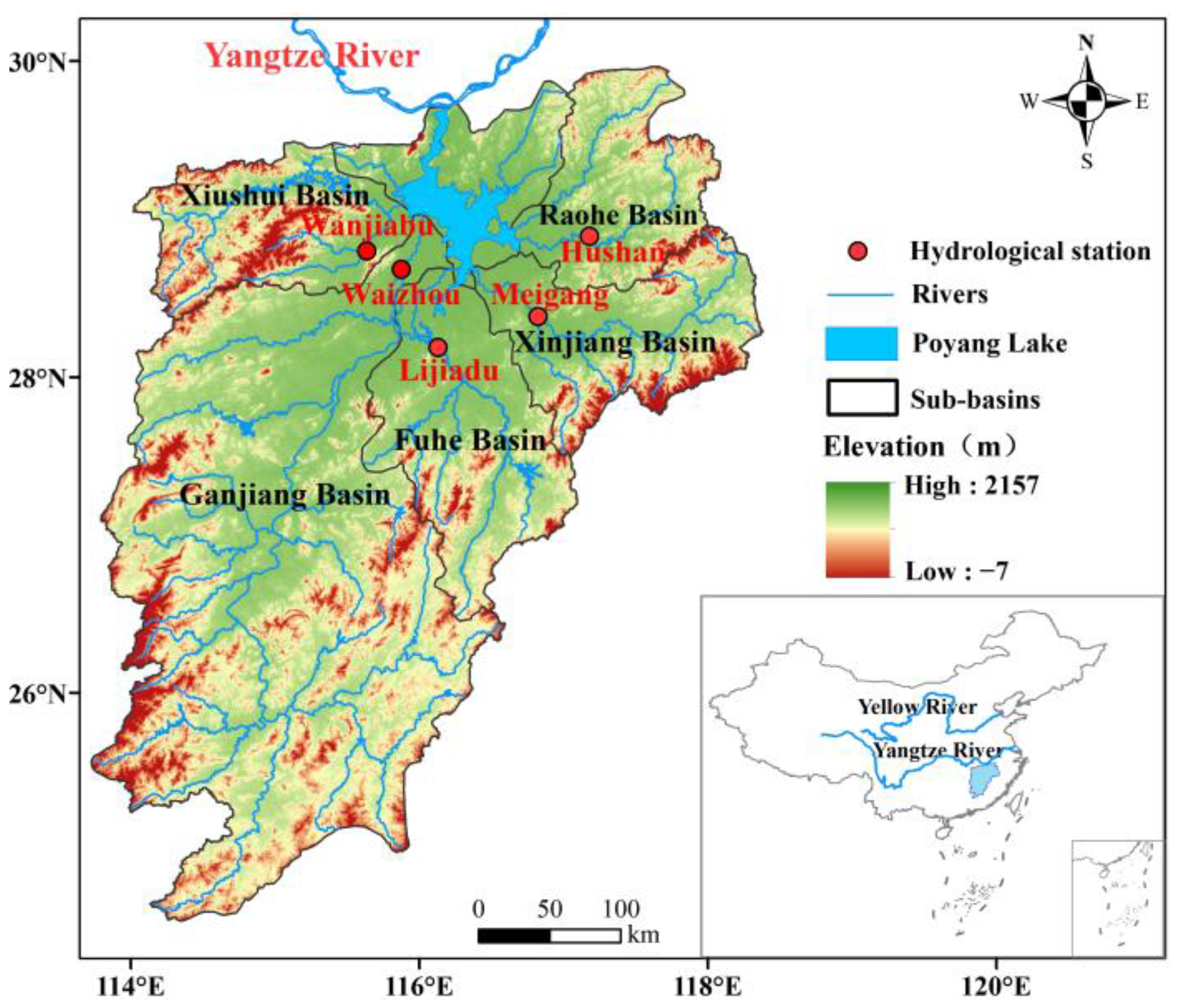
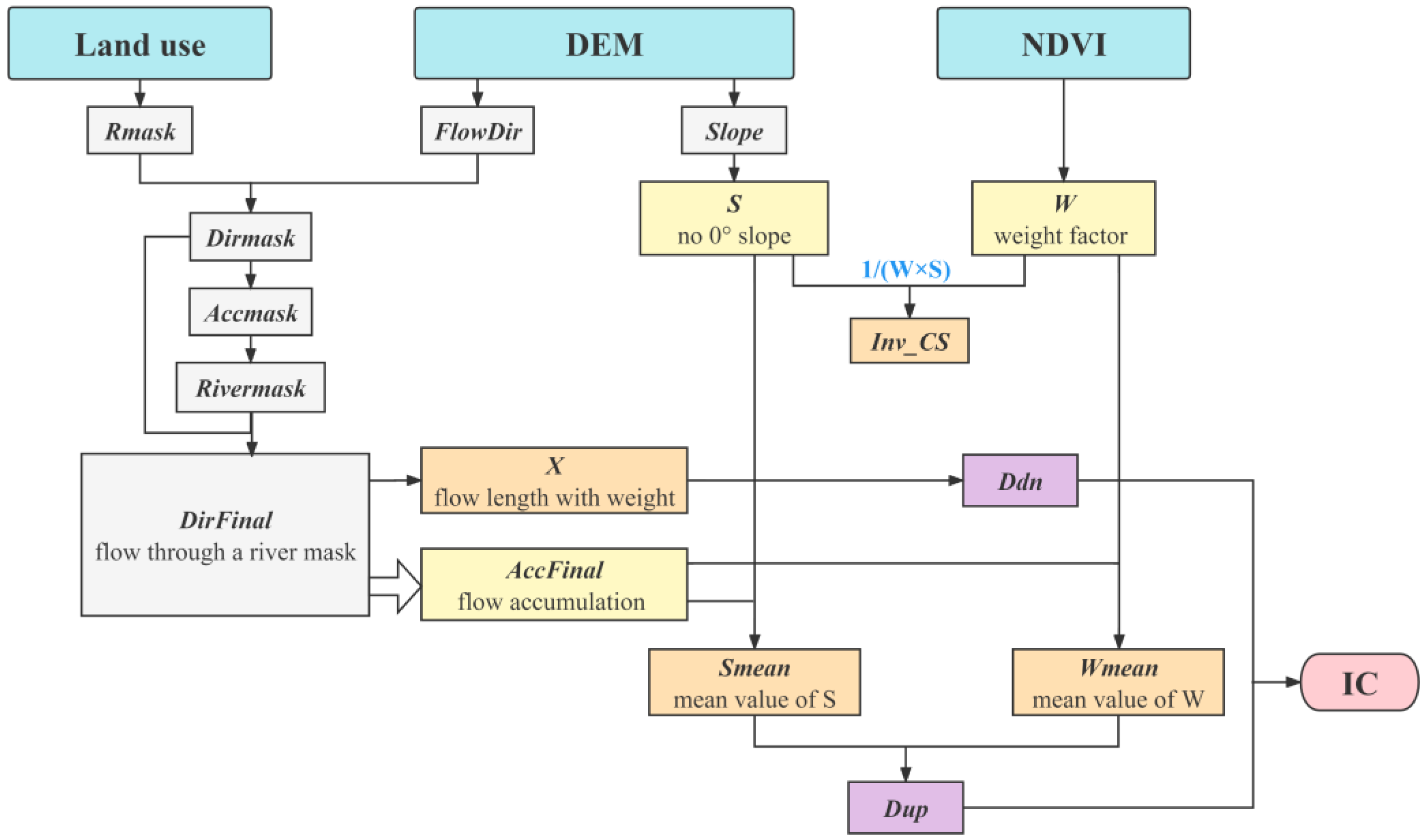

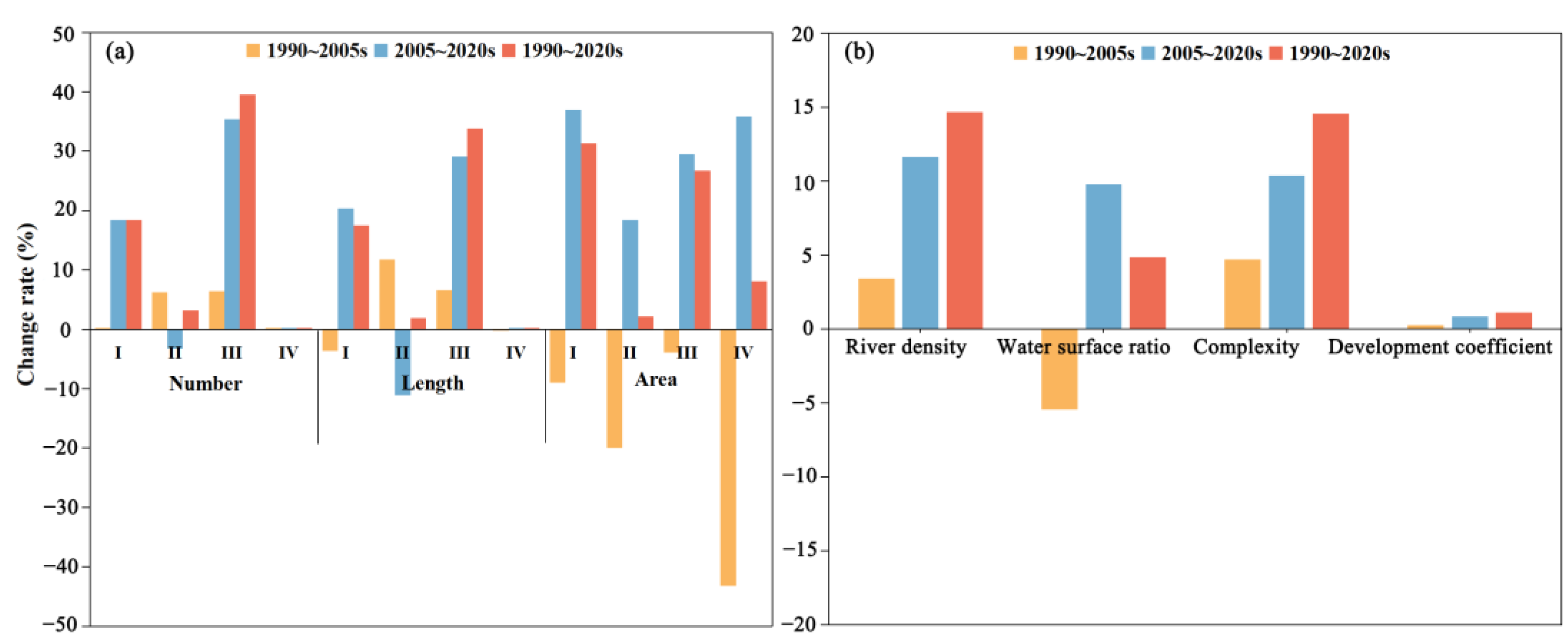
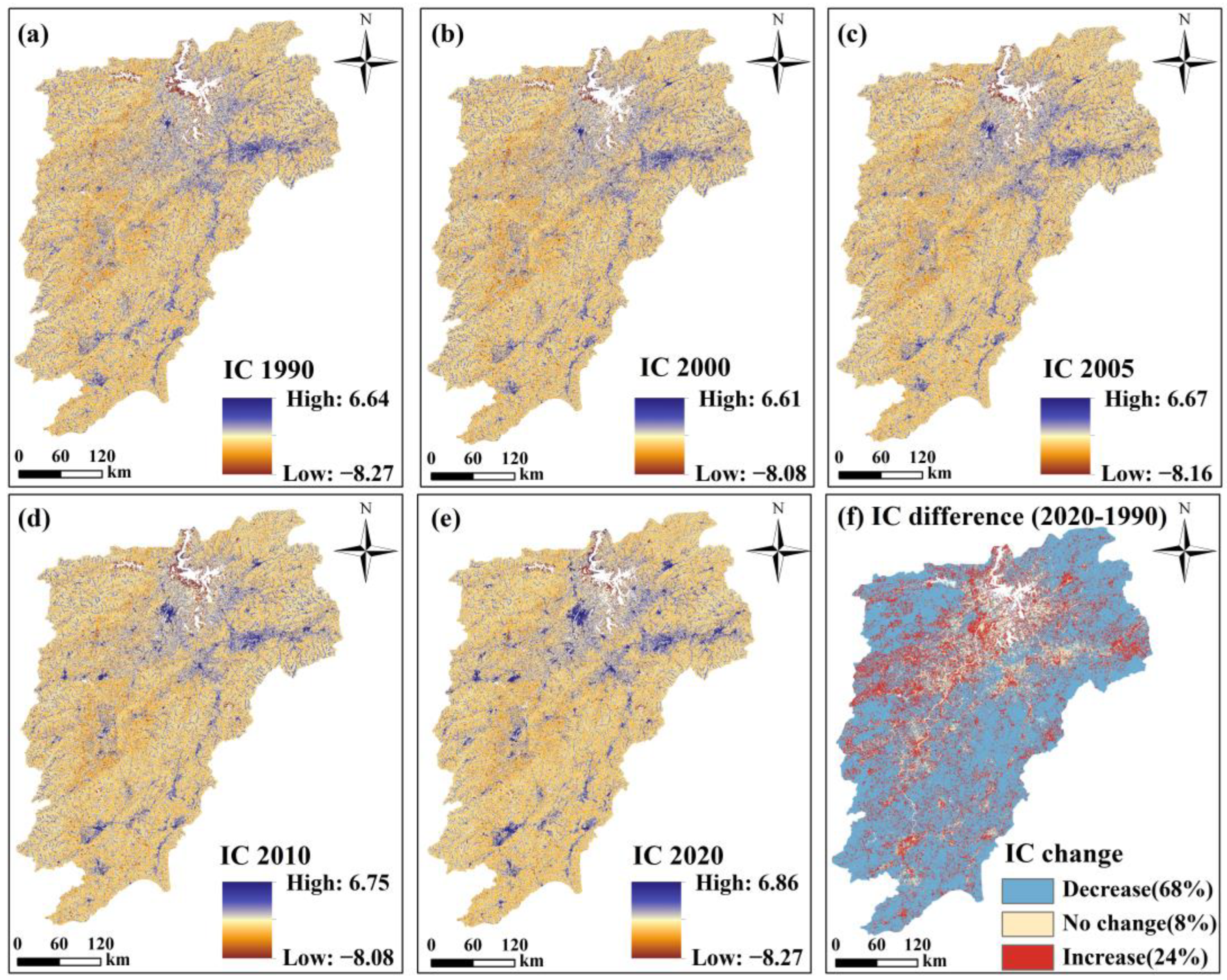


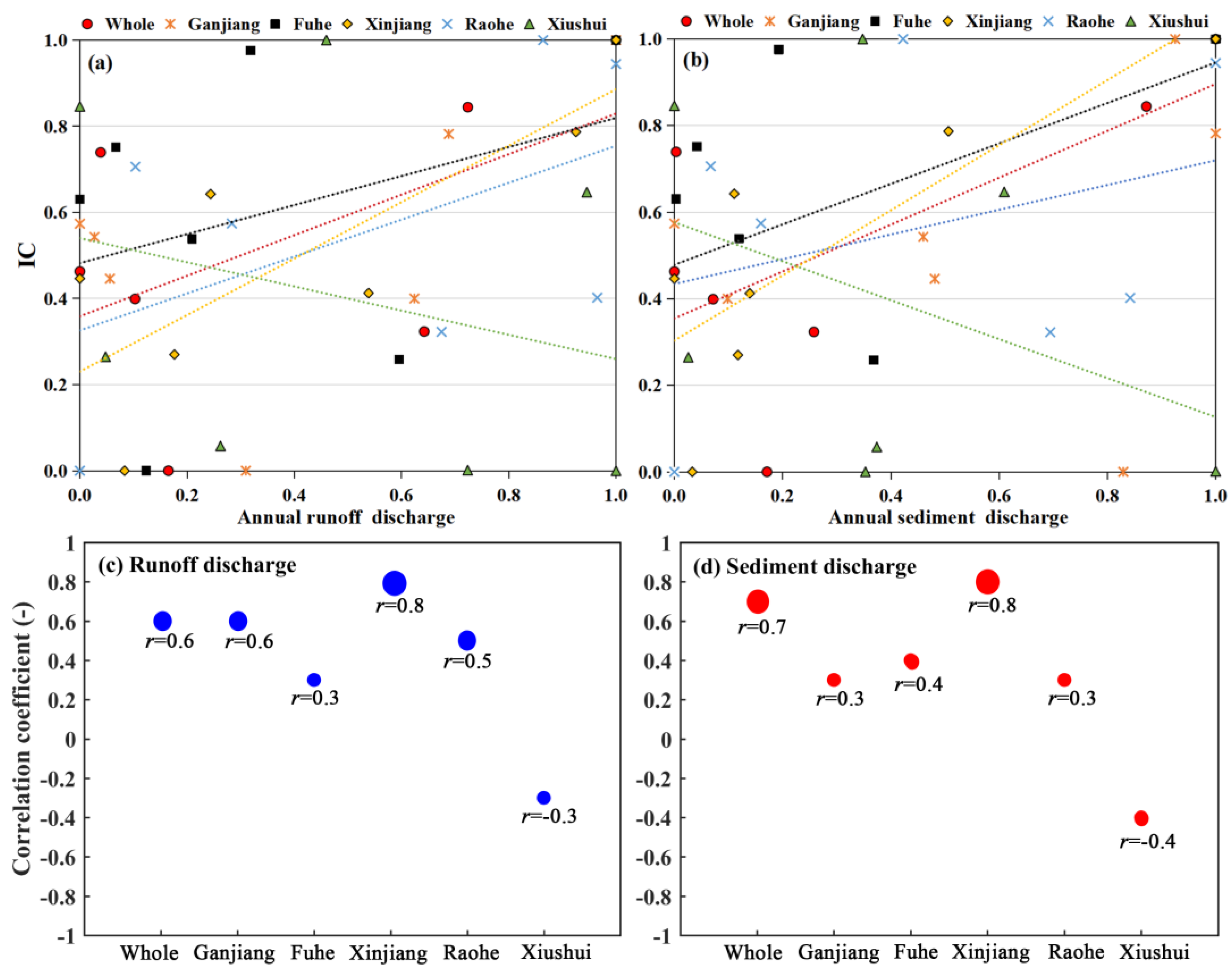
| Types | Indicators | Computational Methods | |
|---|---|---|---|
| Quantity | River density Water surface ratio | L is the total length of the river | |
| A is the total area of the catchment | |||
| is the total area of the river | |||
| Morphometric | River complexity River development coefficient | is the number of the river classes | |
| is the total length of the tributary | |||
| is the total length of the main river | |||
| Structure | Network circuitry | l is the number of nodes v is the number of river edges | |
| Edge–nodes ratio | |||
| Network connectivity | |||
| Indicator | 1990 | 2000 | 2005 | 2010 | 2020 |
|---|---|---|---|---|---|
| Node number | 108 | 110 | 101 | 115 | 127 |
| River edge number | 204 | 207 | 212 | 221 | 247 |
| Network circuitry α | 0.46 | 0.46 | 0.57 | 0.48 | 0.49 |
| Edge–nodes ratio β | 1.89 | 1.88 | 2.10 | 1.92 | 1.94 |
| Network connectivity γ | 0.64 | 0.64 | 0.71 | 0.65 | 0.66 |
Disclaimer/Publisher’s Note: The statements, opinions and data contained in all publications are solely those of the individual author(s) and contributor(s) and not of MDPI and/or the editor(s). MDPI and/or the editor(s) disclaim responsibility for any injury to people or property resulting from any ideas, methods, instructions or products referred to in the content. |
© 2023 by the authors. Licensee MDPI, Basel, Switzerland. This article is an open access article distributed under the terms and conditions of the Creative Commons Attribution (CC BY) license (https://creativecommons.org/licenses/by/4.0/).
Share and Cite
Zeng, B.; Li, Y.; Yao, J.; Tan, Z. The Characteristics and Evolution of Structural and Functional Connectivity in a Large Catchment (Poyang Lake) during the Past 30 Years. Remote Sens. 2023, 15, 3335. https://doi.org/10.3390/rs15133335
Zeng B, Li Y, Yao J, Tan Z. The Characteristics and Evolution of Structural and Functional Connectivity in a Large Catchment (Poyang Lake) during the Past 30 Years. Remote Sensing. 2023; 15(13):3335. https://doi.org/10.3390/rs15133335
Chicago/Turabian StyleZeng, Bingru, Yunliang Li, Jing Yao, and Zhiqiang Tan. 2023. "The Characteristics and Evolution of Structural and Functional Connectivity in a Large Catchment (Poyang Lake) during the Past 30 Years" Remote Sensing 15, no. 13: 3335. https://doi.org/10.3390/rs15133335
APA StyleZeng, B., Li, Y., Yao, J., & Tan, Z. (2023). The Characteristics and Evolution of Structural and Functional Connectivity in a Large Catchment (Poyang Lake) during the Past 30 Years. Remote Sensing, 15(13), 3335. https://doi.org/10.3390/rs15133335






